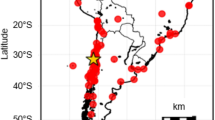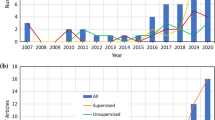Abstract
Earthquakes affect the entire world and have catastrophic consequences. On May 12, 2008, an earthquake of magnitude 7.9 on the Richter scale occurred in the Wenchuan area of Sichuan province in China. This event, together with subsequent aftershocks, caused many avalanches, landslides, debris flows, collapses, and quake lakes and induced numerous unstable slopes. This work proposes a methodology that uses a data mining approach and geographic information systems to predict these mass movements based on their association with the main and aftershock epicenters, geologic faults, riverbeds, and topography. A dataset comprising 3,883 mass movements is analyzed, and some models to predict the location of these mass movements are developed. These predictive models could be used by the Chinese authorities as an important tool for identifying risk areas and rescuing survivors during similar events in the future.













Similar content being viewed by others
References
Başoğlu, M., Salcioğlu, E., & Livanou, M. J. (2002). Traumatic stress responses in earthquake survivors in Turkey. J Trauma Stress, 15(4), 269–276.
Cascini, L., Cuomo, S., & Sorbino, G. (2005). Flow-like mass movements in pyroclastic soils: remarks on the modelling of triggering. Italian Geotechnical Journal., 4, 11–31.
Chigiraa, M., Wub, X., Inokuchic, T., & Wang, G. (2010). Landslides induced by the 2008 Wenchuan earthquake, Sichuan, China. Geophys J Roy Astron Soc, 118(4), 225–238.
Corominas, J., et al. (2003). Integrated landslide susceptibility analysis and hazard assessment in the principality of Andorra. Nat Hazards, 30, 421–435.
Costa, J. E. and Wieczorek, G.F., 1987 Debris flow/avalanches: process, recognition and mitigation. Geol. Soc. Am., Rev. Eng. Geol., VII, 63–79.
Pyle, D. (1999). Data preparation for data mining. San Francisco: Morgan Kaufmann.
Dunning, S. A., Massey, C. I., & Rosser, N. J. (2009). Structural and geomorphological features of landslides in the Bhutan Himalaya derived from Terrestrial Laser Scanning. Geophys J Roy Astron Soc, 103, 17–29.
Golub, G. H., Heath, M., & Wahba, G. (1979). Generalized cross-validation as a method for choosing a good ridge parameter. Technometrics., 21, 215–223.
Goruma, T., et al. (2011). Distribution pattern of earthquake-induced landslides triggered by the 12 May 2008 Wenchuan earthquake. Geophys J Roy Astron Soc, 133, 152–167.
Grother, P. J., Candela, G. T., & Blue, J. L. (1997). Fast implementation of nearest neighbour classifiers. Pattern Recognition., 30, 459–465.
Han, J., & Kamber, H. (2001). Data mining—concepts and techniques. San Francisco: Morgan Kaufmann.
Klimeš, J., Vilímek, V., & Omelka, M. (2009). Implications of geomorphological research for recent and prehistoric avalanches and related hazards at Huascaran, Peru. Natural Hazards., 50, 193–209.
Knutti, R., Stocker, T. F., Joos, F., & Plattner, G.-K. (2003). Probabilistic climate change projections using neural networks. Clim. Dyn., 21, 257–272.
McCuen, R. H., Knight, Z., & Cutter, A. G. (2006). Evaluation of the Nash—Sutcliffe Efficiency Index. Journal of Hydrologic Engineering, 11, 597–602.
Mitchell, T. M. (1997). Machine learning. New York: McGraw-Hill.
Pla, I., & Nacci, S. (2001). Impacts of mechanization on surface erosion and mass movements in vineyards of the Anoia-Alt Penedés Area (Catalonia, Spain). In Sustaining the Global Farm, 812–816.
Shen, Z. K. (2009). Revealing ruptures. Nat Geosci, 2, 732.
Si, H. et al., 2009. On attenuation characteristics of PHA and its implications to damage during the M8.0 Wenchuan Earthquake, China. Wenchuan Earthquake: One Year After, Special Session I.
Souza, F. T., & Ebecken, N. (2012). A data based model to predict landslide induced by Rainfall in Rio de Janeiro City. Geotechnical and Geological Engineering., 30, 85–94.
Watanabe, T. Hiramatsu,Y. and Obara, K. 2007. Scaling relationship between the duration and the amplitude of non-volcanic deep low-frequency tremors. Geophysical Research Letters, vol. 34, number 7.
Zheng-Kang, S., et al. (2009). Slip maxima at fault junctions and rupturing of barriers during the 2008 Wenchuan earthquake. Nat Geosci, 2, 718–724.
Acknowledgments
I would like to thank Tsinghua University for the financial and logistical support it provided for this study. I also would like to thank the institutions that provided the data used in the study: the Geomechanical Institute (Chinese Ministry of Land and Resources); the China Earthquake Geospatial Research Portal; the University of Colorado Department of Geography; and the Tsinghua University State Key Laboratory of Hydroscience and Engineering.
Author information
Authors and Affiliations
Corresponding author
Rights and permissions
About this article
Cite this article
de Souza, F.T. A data-based model to locate mass movements triggered by seismic events in Sichuan, China. Environ Monit Assess 186, 575–587 (2014). https://doi.org/10.1007/s10661-013-3400-3
Received:
Accepted:
Published:
Issue Date:
DOI: https://doi.org/10.1007/s10661-013-3400-3




